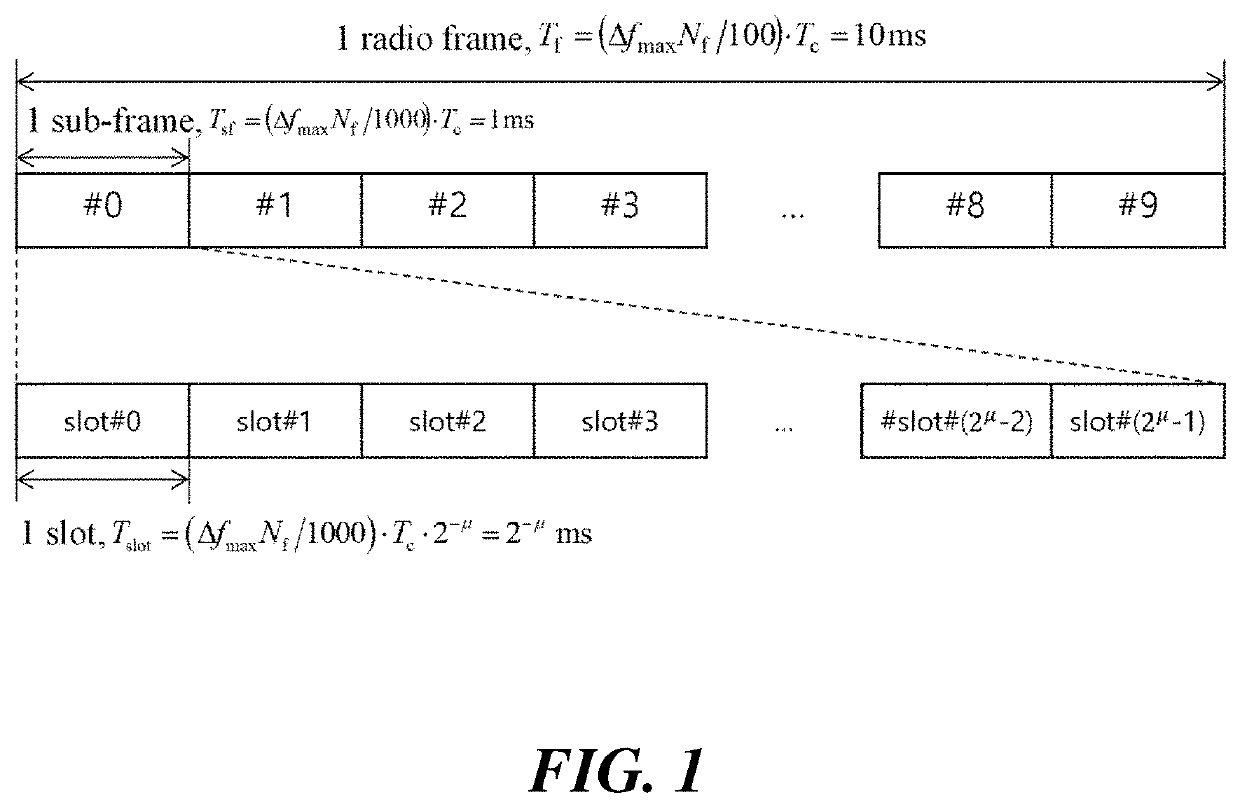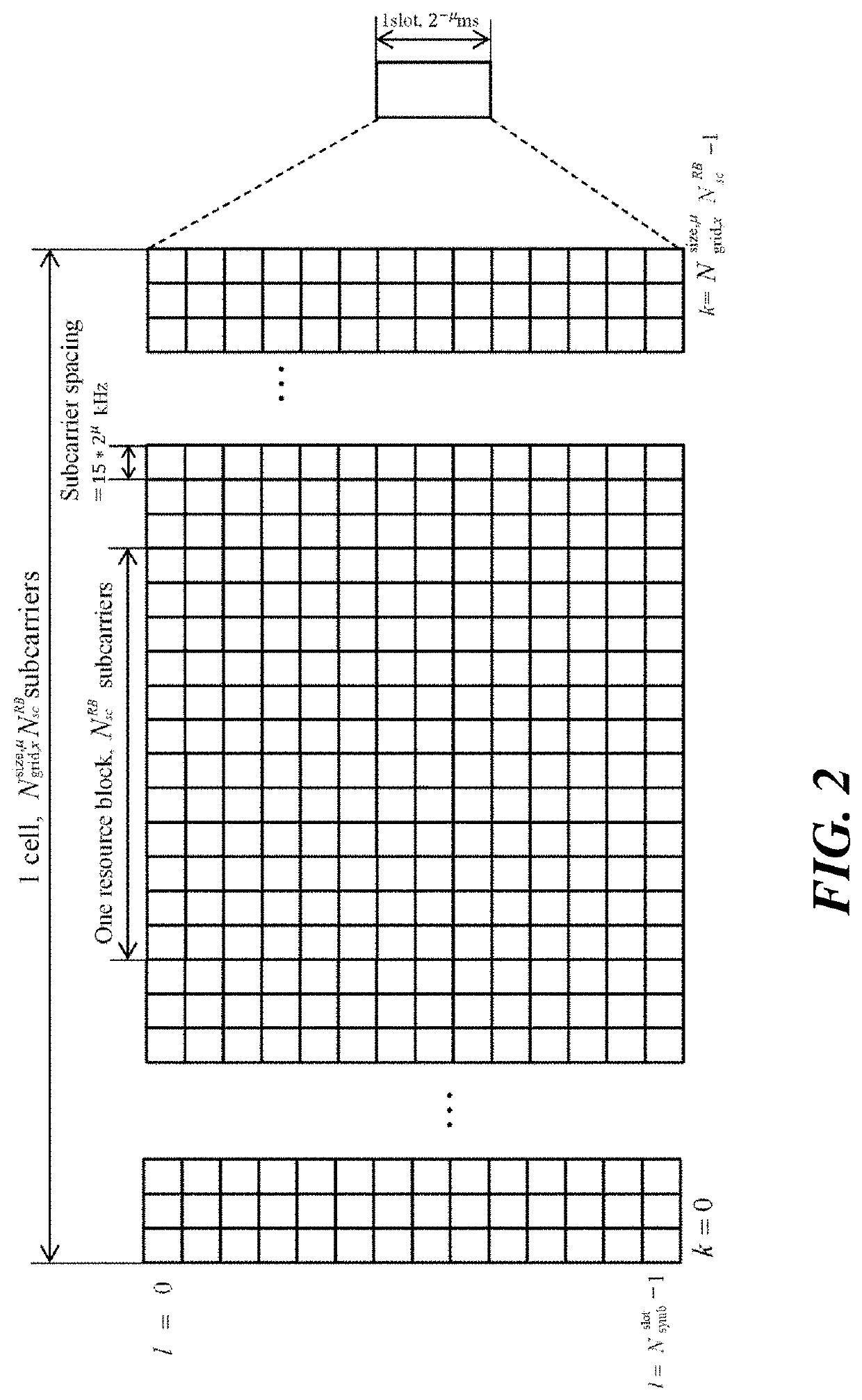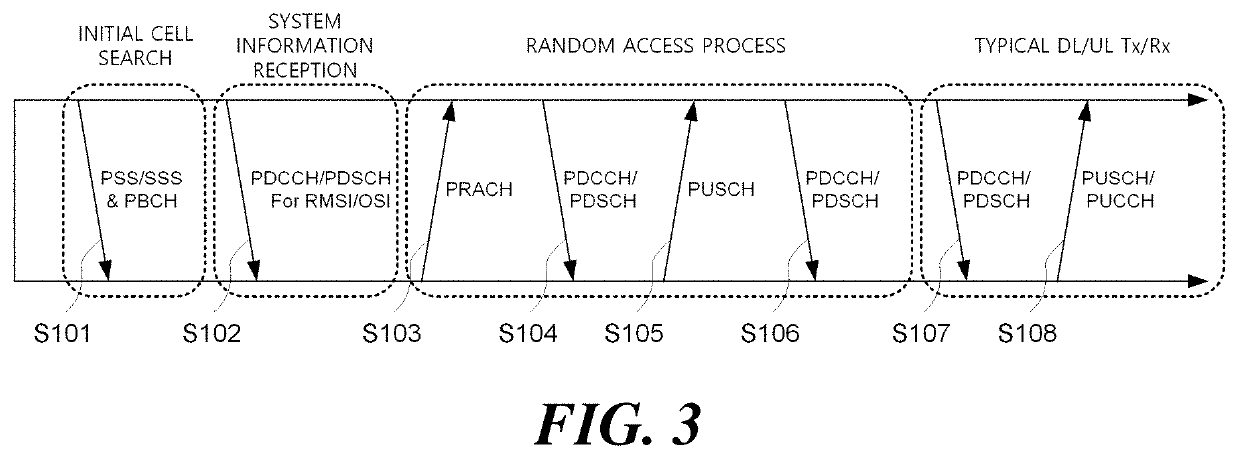Resource allocation method, device and system of wireless communication system
a wireless communication system and resource allocation technology, applied in the field of wireless communication system, to achieve the effect of efficient transmission and receiving signals
- Summary
- Abstract
- Description
- Claims
- Application Information
AI Technical Summary
Benefits of technology
Problems solved by technology
Method used
Image
Examples
embodiment 1
d Scheduling
[0141]The UE may determine a resource block group (RBG) size P according to the number of PRBs included in the BWP. RBG is a basic unit of a bit-map-based resource allocation method (e.g., RA type 0), and one RBG is composed of P consecutive PRBs. Referring to Table 4, one of two configurations for RBG size P can be configured as RRC, and as the PRB number of the BWP is larger, the UE may have a larger RBG size (P) value. In a BWP having N PRBs, a RA field for bit-map based resource allocation requires a ceil (N / P) bit. For example, if BWP is composed of 40 PRBs and Configuration 1 is configured, RBG size P=4. That is, four (consecutive) PRBs are grouped to form one RBG, and ten RBGs are used for resource allocation. At this time, the RA field needs 10 bits.
TABLE 4Carrier Bandwidth Part Size(the number of PRBs)Configuration 1Configuration 21~20P = 2P = 421~50 P = 4P = 851~100P = 8P = 16101~P = 16P = 16
[0142]Different BWPs can be configured to have different numbers of PR...
embodiment 2
ased on Resource Indication Value (RIV)
[0161]As a method for indicating continuously allocated resources, the RIV method is used in LTE. In LTE DL type-2 resource allocation, continuous RB is allocated using the RIV method. More specifically, PDCCH DCI format, 1A, 1B, 1D and EPDCCH DCI format 1A, 1B, 1D, and MPDCCH DCI format 6-1A have RIV values, and through the RIV values, the starting RB index RBstart and the number of consecutively allocated RBs LCRBs can be determined. Here, RB may mean a virtual resource block (VRB) or a physical resource block (PRB). In the existing LTE, the RIV value is determined as follows.
if(LCRBs-1)≤⌊NRBDL / 2-thenRIV=NRBDL(LCRBs-1)+RBstartelseRIV=NRBDL(NRBDL-LCRBs+1)+(NRBDL-1-RBstart)whereLCRBs≥1andshallnotexceedNRBDL-RBstart.[Equation1]
[0162]Here, NDLRB is the number of RBs of DL bandwidth (BW). When the RIV-based resource allocation method is used for uplink, NDLRB may be replaced with NDLRB of RB number of UL BW. When BWP is...
embodiment 3
e
[0253]Another problem to be solved in the present invention relates to a case in which the UE fails to receive DCI carrying UL BWP switching information. The DCI that delivers the switching information of the UL BWP may include a BPI for UL BWP. In this case, the UE may determine that the UL BWP indicated by the DCI's BPI is an active UL BWP. In order to receive the DCI (DCI format 0_1) for scheduling PUSCH, the UE needs to know the length (e.g., number of bits) of the frequency domain resource allocation field included in the DCI. For example, the length of the frequency domain resource allocate field of the UE configured with RA type 0 (bit-map method) is equal to the number of RBGs included in the active UL BWP, and the length of the frequency-domain RA field of the UE configured with RA type 1 (RIV method) is equal to ceil (log2 (N_PRB*(N_PRB+1) / 2)). Here, N_PRB is the number of PRBs of the active UL BWP. That is, in order to know the length (e.g., number of bits) of the DCI th...
PUM
 Login to view more
Login to view more Abstract
Description
Claims
Application Information
 Login to view more
Login to view more - R&D Engineer
- R&D Manager
- IP Professional
- Industry Leading Data Capabilities
- Powerful AI technology
- Patent DNA Extraction
Browse by: Latest US Patents, China's latest patents, Technical Efficacy Thesaurus, Application Domain, Technology Topic.
© 2024 PatSnap. All rights reserved.Legal|Privacy policy|Modern Slavery Act Transparency Statement|Sitemap



